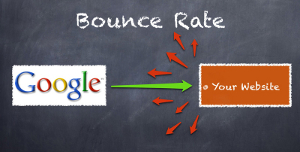You are viewing our site as an Agent, Switch Your View:
Agent | Broker Reset Filters to Default Back to ListUnderstanding and Interpreting Bounce Rates
November 05 2013
 Google Analytics is the most popular and one of the most comprehensive website analytical resources out there--not to mention that it's free. Once it's installed and working, there will be a wealth of data available to help you to measure your site's performance. Just a few of dozens of analytical data sets are:
Google Analytics is the most popular and one of the most comprehensive website analytical resources out there--not to mention that it's free. Once it's installed and working, there will be a wealth of data available to help you to measure your site's performance. Just a few of dozens of analytical data sets are:
- Number of unique and returning visitors to the site.
- Pages the visitors enter in and leave from when visiting.
- How many pages are viewed in total and average per visitor?
- Average time on the site for each visitor.
- Which pages are visited, and even in what order, from one to another.
- Referring site information telling you where visitors came from via links.
- Search engine keywords and phrases that brought visitors to your site.
- ...and much more!
One of the data sets you'll be checking is the "Bounce Rate." This is measured differently by some analytics programs, but Google considers a "bounce" as happening when a visitor to your site enters and leaves from the same page. In other words, they only view a single page. It's not about how long they're there, only about their viewing of only a single page.
It's easy to get very concerned about your site's bounce rates, as they can seem quite high. If you read some of the guru articles about analytics, and they're touting very low (under 25% - 35%) bounce rates, you can lose sleep finding that yours can be much higher.
There is an average bounce rate for your site made up of the bounce rates for each and every page, and also broken out into bounce rates based on the way they came to your site. In other words, you'll have a bounce rate average for visitors from free searches (SEO), another for paid searches (PPC), and others broken out by search engine, site referrals, and many more variables.
So, the first thing to remember is that there will be high bounce rates for certain visitor types and certain referring sites or search referral sites. If you have a lot of area information, neighborhood pages, shopping info pages, and entertainment articles, then you can see very high bounce rates for those pages if your SEO is working. Someone searches for "yourtown shopping malls," arrives on your page about them, finds the information they wanted, and they leave. This isn't a bad thing, just the nature of the information and the searcher's requirements.
Another factor that really runs up your bounce rate numbers is a really great IDX search page or a few of them. They find a great IDX resource, so they bookmark it and return frequently. They come, search, leave, and return and do it again and again. Every one of those single page visits is considered a "bounce," but you shouldn't be unhappy about it.
By providing a resource that brings repeat visitors, you are keeping your name and site in their bookmarks until they're ready to buy or sell real estate. They value your site and the tools you provide. By using the many lead generation features included with your WebsiteBox IDX, you'll create loyal visitors, and you'll capture their contact information on one of their many return visits.
To view the original article, visit the WebsiteBox blog.









